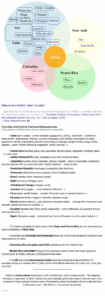
Image, © 2025 [Buscando Guayaba]
Diagrama de la salsa CC BY-SA 4.0
Salsa is not a rhythm; “salsa” is a label.
Salsa, then, has no nomenclature, nor does it need one. Salsa is not a rhythm, nor merely a style that fits a fixed rhythm. Salsa is an open form […]. The Book of Salsa: A Chronicle of Urban Music from the Caribbean to New York City., 1971 (trad. in English 2008) – César Miguel Rondón 🇻🇪
Countries and rhythms that have influenced salsa (This diagram and the list below are not intended to be exhaustive).
- Cuba (son, rumba – rumba complex: guaguanco, yambu, columbia -, santeria is transversal – batá drums, themes, Lucumi vocabulary, and orishas are present in salsa – guaracha, mambo, chachacha, danzón, bolero, mozambique, changui, nengón, kiriba, songo, timba, reparto – urban rhythm blending reggaeton, timba, and rap –
- Puerto Rico (bomba, plena, seis, aguinaldo, décima jibara, reggaetón, romantic salsa or salsa rosa –
- United States (NYC) (jazz, boogaloo, soul, funk, rhythm & blues)
- Colombia (cumbia, porro, vallenato, Joeson, mapalé – salsa is essentially Caribbean, but also blends with currulao and other Pacific rhythms -, salsa choke)
- Dominican Republic (merengue, mangulina, palo, bachata)
- Venezuela (Barlovento drums, joropo, urban Caribbean spirit)
- Brazil (samba, choro, maracatú, baião)
- Haiti (compas, méringue, rara)
- Trinidad and Tobago (calypso, soca)
- Jamaica (ska, reggae – in its rhythmic influence -)
- Peru (cajón, landó, festejo – via afro-Peruvian roots in modern fusions -)
- Panama (tamborito, reggae in Spanish, calypso congo)
- Mexico (Latin American romantic ballad, – among other harmonic and melodic influences such as corridos – “Rumberas” films.)
- Ecuador (bomba del Chota, pasillo, sanjuanito – minor influence, but present among some performers –
- Spain (flamenco, copla – lyrical and harmonic influences in some sa/sa-boleros -)
- The main foundation of salsa comes from Cuba and Puerto Rico, but the phenomenon was consolidated in New York.
- Countries like Colombia and Venezuela were key in the local expansion, evolution, and tropicalization of salsa.
- Colombia, Peru, Ecuador, and Chile contribute the Afro-Pacific root.
- Brazil, Peru, and Haiti bring rhythmic and percussive colors that today appear in fusions such as timba, Latin jazz, and experimental salsa.
- The UK and other international styles have also influenced salsa rhythms. For example, songo is a modern Afro-Cuban rhythm that blends elements of rumba, son, funk, jazz,
Salsa is a transcultural expression, both afrodiasporic and eurodescendant. This diagram attempts to represent its direct influences, acknowledging that the indirect ones are even more numerous. It also includes some musics influenced by salsa and modern rhythms derived from it, because music -like history— is a round-trip journey.
Andrés
